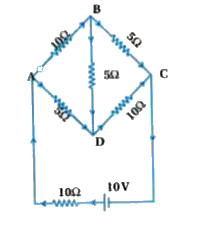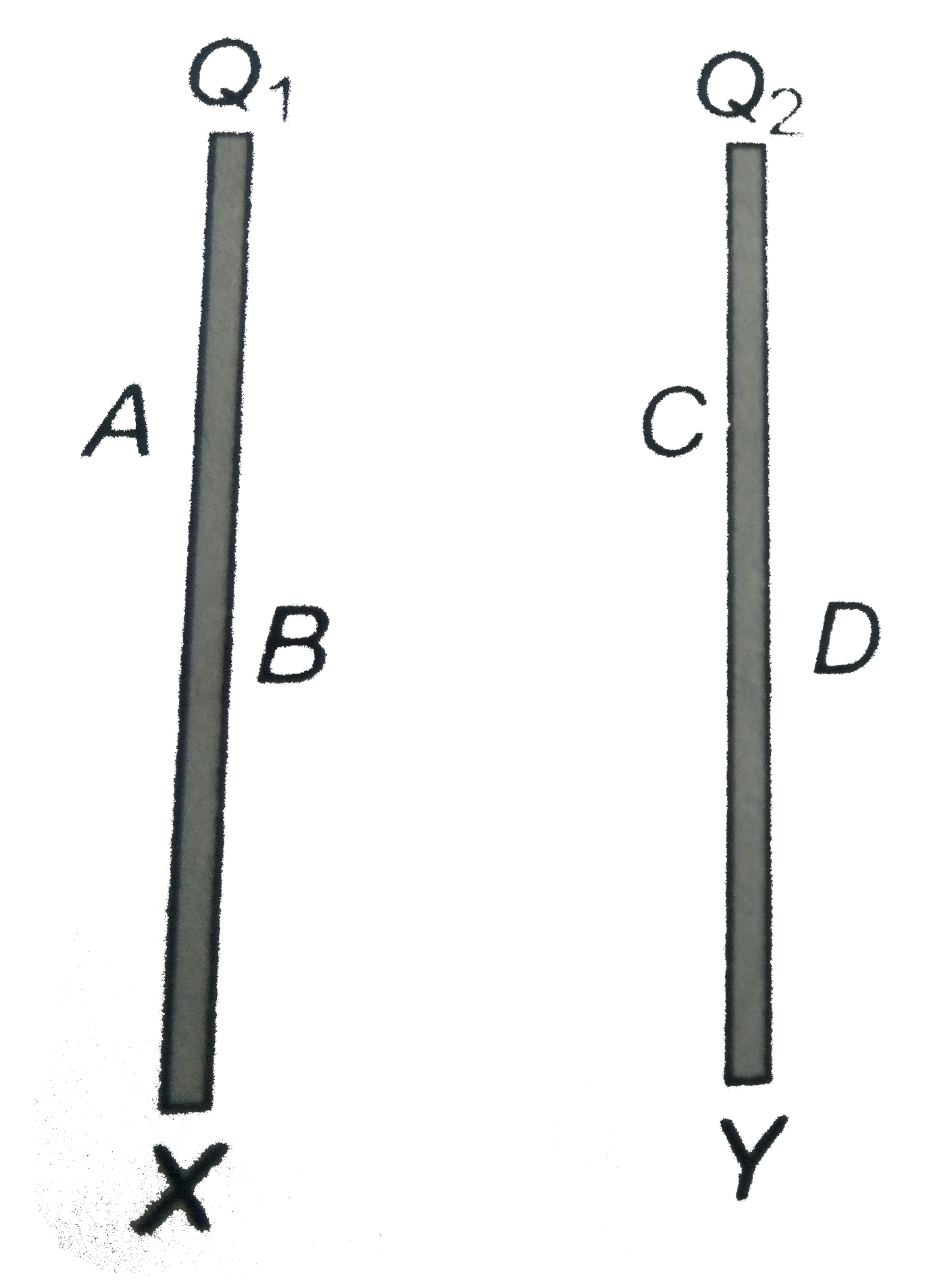Answer carefully:
(a) Two large conducting spheres carrying charges Q1 and Q2 are brought close to each other. Is the magnitude of electrostatic force between them exactly given by Q1,Q2/4πε0r2, where r is the distance between their centres?
(b) If Coulomb’s law involved 1/r3 dependence (instead of would Gauss’s law be still true ?
(c) A small test charge is released at rest at a point in an electrostatic field configuration. Will it travel along the field line passing through that point?
(d) What is the work done by the field of a nucleus in a complete circular orbit of the electron? What if the orbit is elliptical?
(e) We know that electric field is discontinuous across the surface of a charged conductor. Is electric potential also discontinuous there?
(f) What meaning would you give to the capacitance of a single conductor?
(g) Guess a possible reason why water has a much greater dielectric constant (= 80) than say, mica (= 6).Solution in Gujrati
The capacitance of a single conductor as a parallel plate capacitor will one of its two plates at infinity. Hence, they constitute a capacitor and posses capacitances.
Topper's Solved these Questions
- ELECTROSTATIC POTENTIAL AND CAPACITANCEBOOK - KUMAR PRAKASHANCHAPTER - ELECTROSTATIC POTENTIAL AND CAPACITANCEEXERCISE - Section B ( Numerical From DARPAN. Based on Textbook )
19 Videos
- ELECTROSTATIC POTENTIAL AND CAPACITANCEBOOK - KUMAR PRAKASHANCHAPTER - ELECTROSTATIC POTENTIAL AND CAPACITANCEEXERCISE - Section B (questions)
2 Videos
- ELECTROSTATIC POTENTIAL AND CAPACITANCEBOOK - KUMAR PRAKASHANCHAPTER - ELECTROSTATIC POTENTIAL AND CAPACITANCEEXERCISE - Section B Numericals
16 Videos
- ELECTROMAGNETIC WAVESBOOK - KUMAR PRAKASHANCHAPTER - ELECTROMAGNETIC WAVESEXERCISE - BOARD.S QUESTION PAPER MARCH - 2020 (PART - B) SECTION - C
5 Videos
- MAGNETISM AND MATTERBOOK - KUMAR PRAKASHANCHAPTER - MAGNETISM AND MATTEREXERCISE - SECTION D Multiple Choice Questions (MCQs) (MCQs asked in Competitive Exams) MCQs asked in Board Exam and GUJCET
7 Videos
Similar Questions
An electric field is represented by →E=Axˆi where A = 10Vm2 . Find the potential of the origin with respect to the point (10,20) m.
View SolutionA slab of material of dielectric constant K has the same area as the plates of a parallel plate capacitor but has a thickless (12)d. Where d is the separation of the plates . How is the capacitance changed when the slab is inserted between the plates
View SolutionCalculate the potential at a point P due to a charge of 4×10−7 C located 9 cm away.
View SolutionDetermine the current in each branch of the given network.

View SolutionAt a place on earth the vertical component of earth's magnetic field is √3 times its horizontal component. The angle of dip at this place is …...
View SolutionTwo large conduction spheres carrying charges Q_(1) and Q_(2) are brought close to each other. Is the magnitude of the force between them exactly given by Q_(1)Q_(2)//4piepsilon_(0)r^(2) . Where r is the distance between their centers.
View SolutionTwo large , parallel conducting plates X and Y , kept close to each other , are given Q1 and Q2(Q1>Q2). The four surfaces of the plates are A,B,C and D , as shown

(i) The charge on A is 12(Q1+Q2)
(ii) The charge on B is 12(Q1−Q2)
(iii) The charge on C is 12(Q2−Q1)
(iv) The charge on D is 12(Q1+Q2)
View Solutionदो आवेशों q1 तथा q2 के बीच लगने वाला कूलॉम बल, F=q1q2r2 है। एक बल का मान -
View Solutionसावधानीपूर्वक उत्तर दीजिए
दो बड़े चालक गोले जिन पर आवेश Q1और Q2 है ,
एक -दूसरे के समीप लाए जाते है | क्या इनके बीच स्थिर वैद्युत बल का परिमाण तथ्यतः Q1Q24π∈0r2 द्वारा दर्शाया जाता है , जहाँ r इनके केन्द्रो के बीच की दुरी है ?
View SolutionTwo large conducting sphere carrying charges Q1 and Q2 are brought close to each other. Is the magnitude of the electrostatic force between them exactly given by Q1Q2/4π∈0r2, where r is the distance between their centres ?
View SolutionDefine surface density of electric charge.
Two large conducting spheres carrying charges Q1 and Q2 are brought close to each other. Is the magnitude of the electrostatic force between them exactly given by Q1Q24πε0r2 where r is the distance betwen their centres?
View Solutionयदि दो आवेशों q1 व q2 जो एक - दूसरे से दूरी r पर स्थित है के बीच लगने वाला बल F निम्नलिखित सूत्र द्वारा दिया जाता है :
F=14πε0×q1q2r2
तो ε0 का विमीय सूत्र ज्ञात कीजिए।
View SolutionThe electrostatic force between two point charges q_(1) and q_(2) at separation r is given by F= k. (q_(1)q_(2))/(r^(2)) . The constant k
View SolutionIn the following question a statement of assertion (A) is followed by a statement of reason (R ) A : Two large conducting spheres carrying charges Q_(1) and Q_(2) are brought close to each other. The magnitude of electrostatic force between them is exactly given by Q_(1) Q_(2)// 4 pi epsilon_(0) r^(2) , where r is the distance between their centres. R: Here charges Q_(1) and Q_(2) can be assumed to be concentrated at the centres of their respective spheres.
View SolutionAccording to Coulomb's law force between two charges q1 and q2 at 'r' distance apart....
View SolutionAnswer carefully:
(a) Two large conducting spheres carrying charges Q1 and Q2 are brought close to each other. Is the magnitude of electrostatic force between them exactly given by Q1,Q2/4πε0r2, where r is the distance between their centres?
(b) If Coulomb’s law involved 1/r3 dependence (instead of would Gauss’s law be still true ?
(c) A small test charge is released at rest at a point in an electrostatic field configuration. Will it travel along the field line passing through that point?
(d) What is the work done by the field of a nucleus in a complete circular orbit of the electron? What if the orbit is elliptical?
(e) We know that electric field is discontinuous across the surface of a charged conductor. Is electric potential also discontinuous there?
(f) What meaning would you give to the capacitance of a single conductor?
(g) Guess a possible reason why water has a much greater dielectric constant (= 80) than say, mica (= 6).
View Solution
